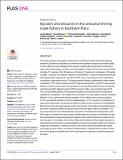Bycatch and discards in the artisanal shrimp trawl fishery in Northern Peru
Abstract
This study analyses the bycatch composition of an artisanal shrimp trawl fleet operating between Cabo Blanco and Máncora in Northern Peru between April 2019 and March 2020. A total of 300 hauls were analysed with respect to target catch and bycatch (consisting of other commercial species, discards, and macroalgae). A total of 277 species were recorded including 111 species of fish, 65 species of molluscs, 51 species of crustaceans, 22 species of algae, 12 species of cnidarian, 9 species of echinoderms, 4 species of Bryozoa and 3 species of polychaeta. Capture per unit effort (CPUE, kg.h-1) was highest for fish, followed by crustaceans, algae and molluscs. The target species Penaeus californiensis coffee shrimp constituted 17.8% of the overall catch,82.2% represented bycatch, and 50.6% represented discards. Coffee shrimps were more abundant in June and November 2019 and in January and February 2020. Highest bycatch CPUE occurred in May, June and December 2019. The most abundant species in the bycatch throughout the study period were sand perch (Diplectrum conceptione, 16% weight of the total catch), the macroalgae caulerpa (Caulerpa filiformis, 13%), sole flounder (Etropus ectenes, 6.4%), Pacific drum (Larimus pacificus, 5.7%), and lumptail searobin (Prionotus stephanophrys, 5.1%). Overall, the contribution of sand perch and flounder, exceeded the weight of coffee shrimp, therefore the interpretation that shrimp is the sole target species needs to be revised. The number of discarded species per month increased towards the spring months with the highest value in November. This study represents the first characterisation of bycatch in the artisanal trawling fishery in the Piura region in northern Peru and reveals a high proportion of bycatch in the fishery but also hints at potential temporal management measures that could be imposed to reduce the levels of bycatch. For example, the months of May and December had the greatest bycatch to shrimp ratios and the fishery could potentially be closed to avoid high bycatch risk, however, longer term information is needed to assess if the trends observed in bycatch are similar over longer periods of time. The species characterisation of bycatch also provides information for the design of modified nets which would target the reduction of small fish present in the catch.
Citation
Mendo , J , Mendo , T , Gil-Kodaka , P , Martina , J , Gómez , I , Delgado , R , Fernández , J , Travezaño , A , Arroyo , R , Loza , K & James , M A 2022 , ' Bycatch and discards in the artisanal shrimp trawl fishery in Northern Peru ' , PLoS ONE , vol. 17 , no. 6 , e0268128 . https://doi.org/10.1371/journal.pone.0268128
Publication
PLoS ONE
Status
Peer reviewed
ISSN
1932-6203Type
Journal article
Description
Funding: Mark James and Tania Mendo appreciate the financial support of the Newton-Paulet Fund (IL 2018-Grant Agreement 414695818 James PER) and Jaime Mendo from the National Fund for Scientific and Technological Development (FONDECYT 2018-222).Collections
Items in the St Andrews Research Repository are protected by copyright, with all rights reserved, unless otherwise indicated.

